#up news live today in hindi
Explore tagged Tumblr posts
Text
मथुरा : विवाद के बाद पड़ोसी ने पुलिस कांस्टेबल मारी गोली...
मथुरा में चार बदमाशों ने बीच चौराहे पर पुलिस कांस्टेबल के सीने में मारी गोली और फिर मौके से फरार हो गए। सदर बाजार थाने के यमुना पार इलाके का अजित सिंह छुट्टी पर आया हुआ था उसका शनिवार रात पडोसी अनिल से झगड़ा हो गया कॉलोनी में हुए झगड़े को मौके पर मौजूद लोगों ने शांत करा दिया इसके बढ़ अजित बुलेट लेकर घर से निकल गया। झगड़े के 1 घंटे बाद अनिल भी अपने चार साथियों के साथ अजित को तलाशता हुआ थाना सदर के…
#Uttar Pradesh#पुलिस#bharat samachar#Breaking news#Crime news#crime news of up#Hindi News#latest hindi news#live breaking news up#live news up#news#news 18#news state#news state live#news state up#news state uttar pradesh live#news state videos#republic bharat#up crime#up crime news#up crime news today#up hindi news#up latest news#up live news#Up news#up news hindi#up news in hindi#up news live#up news live today#up news live today in hindi
0 notes
Text
भाजपा नेता रमेश पासी का हुआ निधन, पूरे इलाके में फैली शोक की लहर; कई नेता अंतिम दर्शन करने पहुंचे
BJP Leader Death: एक तरफ जहां भारतीच जनता पार्टी ने महाराष्ट्र में मुख्यमंत्री पद के लिए देवेंद्र फड़णवीस के नाम का ऐलान कर दिया है, वहीं उत्तर प्रदेश के कौशांबी से दुखद खबर सामने आई है. यहां बीजेपी नेता रमेश पासी का निधन हो गया है. बीजेपी नेता के निधन की खबर लगते ही आसपास के इलाके में शौक की लहर दौड़ गई है. नेता की मौत के खबर लगते ही कार्यकर्ता उनके पार्थिव शरीर के दर्शन के लिए उनके घर पर…
#brajesh misra#Ramesh Pasi News#Ramesh Pasi Passed Away News#show= uttar pradesh news#up news#Uttar Pradesh#uttar pradesh agra news#uttar pradesh chunav#uttar pradesh ka samachar#uttar pradesh ke mukhya samachar#uttar pradesh ke samachar#uttar pradesh ki khabren#uttar pradesh ki news#uttar pradesh news#uttar pradesh news in hindi#uttar pradesh news live#uttar pradesh news today#Uttar Pradesh Police#uttar pradesh police news#uttar pradesh samachar#uttar pradesh shorts
0 notes
Text
The Power of a Name
With @next-pharaoh
The power of a name is something more influential than most people realize. It created an individual, maintained their identity that had been crafted from the womb up until that very point. It interacted with the world around them, choosing their friends, their enemies, their brothers and their lovers. Names decide brains or brawns, cools or fools, the ins and the outs of every living thing. If it was not for names, then who would we even be?
So imagine the power of a name when it is used for the good of a movement, one that has been silently expanding for hundreds of years. While other cultures were fighting wars and attempting to outscore one another, this particular movement stealthily expanded its ranks. Lineage and ancestry can be traced back through countless generations of the male line thanks to this work. Of course, we are speaking of Arabization.
There are obvious reasons as to why this movement is so strong and only has the potential to further dominate. First and most importantly, the Arab-Islamic culture exemplifies masculine ideals, creating stronger men after every new breed. Higher testosterone levels, unbreakable fraternal bonds, governing genetic codes. Their desert-bound history created more aggressive, competitive, and territorial behavior; their strict religious conviction maintain higher levels of confidence and, by right, superiority.
But if this movement is silent, then how are we able to visualize its effects? Consider the following facts: While numbers in almost all historically-dominant religions are dropping, the current Muslim population is predicted to grow more than twice in size by 2060. Islam, and the core values of Arabization along with it, will surpass Christianity as the largest religion in the world in just 25 years.
Reflecting on a local level will help illustrate these details. The branch of mathematics most widely practiced, taught, and respected is algebra, a rhetoric developed into what we use today by Muslim scholars. Arabic speakers have increased by 276% since 1910, with English speakers at 221%, Hindi speakers by 118%, and Mandarin Chinese speakers only by 96% over the same period. The Arabic name Muhammad has risen to become the top-reported baby name in the entire world when all its spellings are counted together, with Amir, Malik, Nasir, and Xavier following close behind.
With all this in mind, how has the Arabization movement utilized the power of a name? How about we make this more personal. Consider the average man, 25 years old, 5’9, and weighs roughly 197 pounds. He is flabby and balding, already considered past his prime at such a young age. Works a meaningless job, lives a meaningless life. His pale skin is a reflection of the blank resume representing his past, present, and future. All this, until a guiding Arab brother calls him by the wrong name.
“Omar!” Omar? But that was not his name. “Omar!” He hears it again, this time from a local. Eventually it seems to resonate with the people around him. At first, this average man was puzzled, but the constant repetition of the name gradually begins to rub softer, washing over his body and smoothing out his ridges. Every "Omar" scrubbed off a piece of his past, better aligning him with a brighter, browner future.
It could start somewhere as vulnerable as porn, the average man filtering through and discarding any videos that do not feature the Arab male. Perhaps his playlists begin to reformat with Arab music, its rhythms and verses constantly playing to further seep into his brain. This restructuring can appear in the home too with a space decorated by Arab imagery, and like a vine it delicately extends further inwards and invades the average man’s very place of rest.
Soon, his interactions with the world around him begin to change. A new Arabic word slips into his everyday language, his connections and role models shift to solely Islamic men, his clothing habits adapt to his beckoning lifestyle. Generic becomes expensive, branded athleisure wear, business becomes religious attire. Each time that new name is uttered, the “Omar” inside inches a little further out.
Eventually, that “Omar” has extended far enough that the results become visibly present. The average man grows taller, broader, his fat stretched against a burgeoning muscular glory. Arms bloat thicker, legs bulge wider. His skin bronzes into a shade of brown that can only be defined as perfection, his hair blackens and thickens across his entire body. The jaw stretches, the nose inflates, the brows and lips protrude. And so too does the average man’s package, its sole purpose to breed future Arabs with its potent seed.
And once "Omar" passes the point of resonation and reaches familiarity, the average man will vanish. The power of a name, his name, Omar, means “long-living, flourishing” in Arabic, his language. And he represents it. An alpha male, an Arab male, a purebred Muslim who understands his mission. So now, Omar takes out his phone and texts a complete stranger, another average man, and simply addresses him as "Ahmed". And the cycle begins once more, the power of a name exploited for the greater good of Arabization.

555 notes
·
View notes
Text
Hello my friends... With my sad words after returning from the cemetery today, full of fear and sadness, I convey to you sad news inside the camp... I woke up today to the screams of a family inside the camp, and the reason was the death of an infant due to the severe cold here inside the tent. The child could not bear that cold... that damned tent... I cannot convey the difficult scenes of his mother and father as they bid farewell to their infant child and they cry over their child. He left and did not see anything of this world. He is a bird in heaven. Now peace be upon his soul. Rest in peace, my little one... I cannot put myself in the place of his parents. I am very scared and devastated. He is not the first child to have this happen, but there are many children who die from the cold, hunger, disease, and bombing here... But I was watching it on the news site, but today I touched it and saw it live. I am afraid for my family... Death is everywhere...


🌟I was Vetted by @gazavetters, my number verified on the list is ( #121 )
🌟I was verified by Butterfly Effect Project’s Line#981
🌟I was verified by Bees And Watermelons line numbers are 204 on the master sheet and 37 on the emergency tab.
🌟I was verified by PaliLiberation Family#132
@postanagramgenerator @prinnay @orchidvioletindigo @pcktknife @planetgraves @vetted-gaza-funds @turtletoria @the-bastard-king @three-croissants @tortiefrancis @sleevesareforlosers @grapejuicedragoon @girlinafairytale @lovewontfindherwayhome @rooh-afza @chronicschmonic @feluka @halalchampagnesocialist @ihavenoideashelp @irhabiya @jezior0 @kordeliiius @neptunerings @malcriada @timetravellingkitty @magnus-rhymes-with-swagness-blog @northgazaupdates2 @rhubarbspring @watermotif @kyra45-helping-others @gaza-evacuation-funds @appsa @emathyst9 @lonniemachin @rairikka @a1m3v @zagreuses-art @lesbianmaxevans @heritagepostsbot @riding-with-the-wild-hunt @90-ghost @magnus-rhymes-with-swagness-blog @troythecatfish @the-bastard-king @paper-mario-wiki @sabertoothwalrus @saberghatz @vague-humanoid @palms-upturned
13 notes
·
View notes
Note
What's up bro? After that lunar landing, India seems like the place to be! Problem is, I don't think the suitcase I brought will be enough for me to last seeing everything from the Taj Mahal to the golden temple. Can I borrow one of the DEL suitcases?
There is actually another suitcase. A fairly new aluminum suitcase from RIMOWA. Looks very expensive. And doesn't necessarily match your dusty and sweaty tourist outfit…. But since no one else has contacted me: Have fun with it!
Delhi… A really huge city. But also really challenging for a tourist who doesn't speak Hindi. But slowly you get used to the strange English they speak here. And somehow you finally find the Airbnb in the old city, a stone's throw from the Red Fort. It smells of sweat, urine and exotic spices in the stairwell. The stairs are steep and you are pretty tired. Heaving your suitcases up is really exhausting. But you have made it. You'll see what's in the big new suitcase tomorrow. You just want to sleep. It looks like the bed in the room hasn't even been made yet. You don't care about that now. Just sleep…
When you wake up the next morning, your old suitcase is gone. But also your old pajamas are gone. You lie naked in bed. And something is different… Your morning wood is hard as steel. Hehehehe, that's not bad… But it's also darker somehow. A shade like a coffee with a shot of milk. Coffee! Yes, you need it now. You get out of the silk-sheeted bed and your boner leads you like a divining rod to the coffee maker in the alcove between your dressing room and the master bath. After the first coffee, quickly take a shower and then get dressed.

And then a second coffee. Your driver will be here soon. Good thing your suitcase is already packed next to you.
You don't like Noida. But many of your friends live there because they have located their startup companies there and it is easier to find capable software developers. But that's not your world either. Your family made their money generations ago in real estate and in the textile industry. And you now head the banking and finance division in your family holding company. After all, you have financed some of your friends' startups. And today one of your friends is getting married. In Noida. You'll survive that, too.
The journey was long, as usual. Getting out of Delhi takes time. But at least you were able to make a number of phone calls while your driver navigated the car safely through the traffic chaos. Now you have moved into your suite. In the corridor hectic movements between the rooms. Bridesmaids and other guests scurry from room to room. You hate this hassle. In life, you would never think of getting married. But the bellboy who carried your suitcase upstairs was hot. You call the front desk and ask for someone to help you unpack your luggage and get dressed. The hotel is one of the most preferred locations for weddings in Noida. You are a regular guest here. They know your preferences. And the bellboys love your cock. You can already imagine that now there will be a fight again, who is allowed to blow you and gets the tip for it.

Yes, that was good… Your cock dangles relaxed between your legs. Your clothes fit perfectly. So on to the ballroom. And let's see who is your boring dinner companion this time.
86 notes
·
View notes
Text
I brushed through A Little Princess today.
It was one of my favourite books when I was younger, and I still quite adore it! I took it down from my bookshelf today and skimmed over it. It was lovely to meet them all again because I’d forgotten the little things, like Melchisedec the rat, Ermengarde, and Lottie. It has been a while since I last read it, and I noticed so many things I didn’t before!
One of the more heartbreaking moments is Sara finding out her papa is dead on her BIRTHDAY. Imagine the pain of an eleven-year-old having to deal with her world turned upside down and losing the only family she has left on her birthday :(
Much as I hate to say it, some parts of the book are a tad racist, although I suppose it’s reflective of the time period in which the book was written (1905).
“It’s a’ Nindian gentleman that’s comin’ to live next door, miss,” she said. [...] He worships idols, miss. He’s an ’eathen an’ bows down to wood an’ stone. I seen a’ idol bein’ carried in for him to worship. Somebody had oughter send him a trac’. You can get a trac’ for a penny.”
Sara is really good with languages (she is shown to be multilingual), which is a trait I adore because I love learning languages too! She speaks both French and Hindi, and it shows up in two very different situations in the book. One to Monsieur Dufarge, the French teacher, and the other to Ram Dass, the Indian servant. The descriptions of both men’s reactions to hear a child speaking their respective languages are strikingly similar.
“Monsieur Dufarge began to smile, and his smile was one of great pleasure. To hear this pretty childish voice speaking his own language so simply and charmingly made him feel almost as if he were in his native land - which in dark, foggy days in London sometimes seemed worlds away.”
“She thought she had never seen more surprise and delight than the dark face expressed when she spoke in the familiar tongue. The truth was that the poor fellow felt as if his gods had intervened, and the kind little voice came from heaven itself.”
As someone who speaks passable Hindi and is currently studying French, this is so sweet and touching! To be in a foreign land and feeling like an outsider, hearing someone speak the same language as you must be so inexpressibly comforting, like you have a comrade and a friend.
Miss Minchin is literally abusive and has a heart of stone. She puts Sara through hell. She also shows severe insecurity and covers it up with projecting her feelings of inadequacy (on a 7 year old!) The scene in Chapter 2 where she concludes that Sara does not know French is especially telling.
“One of Miss Minchin’s chief secret annoyances was that she did not speak French herself, and was desirous of concealing the irritating fact. She, therefore, had no intention of discussing the matter and laying herself open to questioning by a new little pupil.”
I have met quite a few adults like this, who are in the wrong and know it, and unwilling to admit it. They are nice and willing to praise kids and make them their golden child as long as things are going well. The second they are contradicted or called out in the slightest, they turn NASTY. So Miss Minchin, horrid as she is, is written very realistically. Excellent characterisation, and I always like reading the bit where she gets her comeuppance at the end.
My absolutely favourite passage in the book is:
“If I am a princess in rags and tatters, I can be a princess inside. It would be easy to be a princess if I were dressed in cloth of gold, but it is a great deal more of a triumph to be one all the time when no one knows it. There was Marie Antoinette when she was in prison and her throne was gone and she had only a black gown on, and her hair was white, and they insulted her and called her Widow Capet. She was a great deal more like a queen then than when she was so gay and everything was so grand. I like her best then. The howling mobs of people did not frighten her. She was stronger than they were, even when they cut her head off.”
This is off topic, but I read this book right around the time we were learning about the French Revolution in school. So I’d come across Marie Antoinette, but she was portrayed in a very negative light in my history textbook, with the infamous quote: “If they don’t have bread, let them eat cake.” So my initial notion of her jarred completely with what I read here. And that was how I ended up reading and researching more about Marie Antoinette, and got to know that she was an Austrian princess married off very young to a French prince, and mocked for her foreignness. She had several miscarriages and fertility struggles, and she loved kids and adopted a few! True, she did spend rather extravagantly, but she was not quite the villain I took her for. That’s when I realised that history textbooks, more often than not, show only one side of the story.
46 notes
·
View notes
Text
Are you searching for the Best Website Designers in Delhi?
YCCINDIA.COM - Always at your service... Always at your price...
We bring the best results from Google Search Ranking and Social Media Marketing. Trust!! We assure you 100% Satisfaction Results.
Since 1996 we are in a digital world providing services related to the internet field. Having experience of more than 25 years in Website Designing and Digital Marketing we have more than 12000 customers with us.
We optimize the website in such a way that these people reach you as they need your product or service. Some people need information, few require buying something online, so if you have an online presence then you get business.
We provide complete solutions for Website Design and Internet Marketing. Nowadays everyone using smartphones and Google search is on fingertips. Anything that the people require or they need to share is all available on their mobiles and digital device.
YCCINDIA truly believes in the slogan "always at your service... always at your price... We have customized solutions for every new client. We also provide PPC (Pay per Click) Services for Google Advertisements on Desktops, Android, and IOS Mobiles.
With our web design services, there is always a back-end team working for your traffic. We listen to you to make sure your site reflects your style.
Our team helps you gain new customers by optimizing your site for maximum exposure. We even keep your site up-to-date – just call us and we’ll change your text or update your images.
#WebsiteDesignersinDelhi #WebsiteDesigningCompanyinDelhi
#WebsiteDesignerDelhi #WebsiteDevelopmentCompanyinDelhi
Provide our designers with the basics of your business online. Provide examples of websites you like.
Choose your site layout from 100 professional designs and color combinations. Speak directly with our designer to discuss the layout, header design, and other graphics.
Questions along the way? Just pick up the phone or send us an email.
We go to work
After reviewing your information and samples, our expert design staff creates a site based on your instructions.
Your website will be ready for you to review in as little as 5 to 7 days after we’ve received your content for the Standard plan.
Once you’ve approved your site, we send it through our 10-point quality control process and it goes live for the world to see!
We also integrate your Facebook Page, Twitter, and other social accounts with your website.
If you need to update the text or change an image on your site, just contact us.
Recognized as one of the Best Website Designers in Delhi.
Would you like to find the reason how?
Now the big question - How do you get the traffic on your website?
The answer is: Our team works in the backend with the ongoing process known as SEO. Search Engine Optimization will help your business be found by customers looking for what you have to offer.
Search Engine Optimization is the process of improving the organic search engine results for client websites without spending money on Pay Per Click advertising. When potential customers search for your product or service, the website with the stronger SEO will rank higher in the search results. YCCINDIA specializes in helping clients strengthen their website visibility and increase customer conversions.
Social media marketing refers to the process of gaining traffic or attention through social media sites.
Social media marketing is the use of social media platforms to connect with your audience to build your brand, increase sales, and drive website traffic. This involves publishing great content on your social media profiles, listening to and engaging your followers, analyzing your results, and running social media advertisements.
Web Design Company in Delhi - YCCINDIA.COM

Book your appointment today with our technical executive.
24 x 7 Technical Support - Chat in English/Hindi/Marathi/Gujarati
Web Design Company in Delhi - YCCINDIA.COM Always at your service... Always at your price...
Book your appointment today with our technical executive.
Best Website Designing Company in Delhi
https://sites.google.com/yccindia.com...
Send in your business profile and we submit you the best quote for web design and digital marketing.
Chat live online with our marketing executive
#yccindia @yccindia
https://www.youtube.com/watch?v=uBqfx-0xLVA
#website developers in Delhi#website designing company in Delhi#website designer in Delhi#website designers in Delhi#web designing company in Delhi#web designer in Delhi#web developer in Delhi#web development company in delhi
7 notes
·
View notes
Text
youtube
HVAC Contractors in Naperville Illinois Chicago
#hvacmaintenance #aurora #naperville #illinois
India Heating, Air Conditioning and Refrigeration Heating, Air Conditioning and Refrigeration Services
With over 20 years of industry experience, India Heating, Air Conditioning, and Refrigeration is the service company to call.
Committed to delivering on the best customer care, you can expect a hassle-free, professional, and transparent experience when choosing India Heating for your heating, air conditioning, refrigeration, and ventilation needs.
Phone: +16308429754
FINANCING OPTIONS
SCHEDULE YOUR SERVICE
GET ESTIMATE FROM US
Cool Head in the Summer and Warm Heart in the Winter.
HVAC Services
Heating, Air Conditioning and Refrigeration Services
Cooling
Heating
Air Quality
Our Mission & Values:
Our mission at India Heating, Air Conditioning, and Refrigeration is to respond to our customers’ heating and cooling needs as if they were our own. About Us Since 2003, India Heating, Air Conditioning, and Refrigeration have provided services in the Chicago region. Since we completed our first project, the industry has seen significant change, but we remain dedicated to offering the greatest products and top-notch customer service, and we always will be.
When seeking HVAC services, we invite you to choose India Heating, Air Conditioning, and Refrigeration. Heating, Air Conditioning and Refrigeration Services Based in Aurora, the company India Heating, Air Conditioning & Refrigeration provides heating, air conditioning, and commercial refrigeration services.
Only the best HVAC professionals are employed by India Heating, Air Conditioning & Refrigeration to repair or replace your heat pump, ductless mini-split, boiler, walk-in cooler, water heater, and air conditioner.
As a result, you can be confident that you’ve found the appropriate place when you search for “A reputable HVAC business nearby.”
India Heating, Air Conditioning & Refrigeration services all HVAC and refrigeration major brands.
AMC – Maintenance & benefits
AMC of your HVAC system is essential to ensure that it is running efficiently, safely, and reliably throughout the year. Regular maintenance can help improve energy efficiency, increase lifespan, improve indoor air quality, reduce repair costs, and increase safety.
An annual maintenance check-up typically includes an inspection of the system, cleaning of the system, lubrication of moving parts, testing of the system, and recommendations for repairs or upgrades.
AMC CONTRACT
Heating, Air Conditioning and Refrigeration Services Community Involvement Community Involvement India Heating, Air Conditioning & Refrigeration holds the community we serve in high esteem. Our mission is to make a positive impact on the lives of those who call our service area home. We take pride in being associated with the Chicago Andhra Association and the Vidyaranya Kannada Kuta, reflecting our commitment to inclusivity and diversity of cultures. When you contact us,
We can communicate with you in English, Urdu, and Hindi,
Google rating score:4.9 of 5
Cities We Service
Alsip
Aurora
Bartlett
Batavia
Bloomingdale
Bolingbrook
Darien
Glendale Heights
Hanover Park
Montgomery
Naperville
New Lenox
North Aurora
Oak Brook
Oswego
Plainfield
Rolling Meadows
Romeoville
Schaumburg
Shorewood
St. Charles
Streamwood
Tinley Park
Warrenville
West Chicago
Yorkville
Schedule Service Get Your Estimate Financing Options HVAC Company in Aurora Ilinois Proudly Serving Aurora, Naperville, and Bolingbrook
HVAC Contractors in Naperville
Schedule Your Appointment Today!
Phone +1(630) 842-9754
Aurora, IL 60503
Hours Mon – Fri: 8:00am – 5:00pm
Since 2003 INDIA HEATING, AIR CONDITIONING, AND REFRIGERATION
#Aurora#Bolingbrook#Darien#Glendale Heights#Montgomery#Naperville#Oswego#Plainfield#St Charles#HVAC Services#ac maintenance#ac repair#hvac#hvac repair#hvac installation#HVAC Contractors in Naperville#AC installation#AC Repair#ac replacement#hvac technicians#ac repair near me#Cooling#air conditioning#heating#summer#a/c#Youtube
3 notes
·
View notes
Text
By: Jon Haidt and Zach Rausch
Published: May 15, 2023
When parents are asked to identify their top fears about the safety of their children, what do you think tops the list? According to a survey last year by Safehome.org, it’s not cars, strangers, or any other physical threat; it’s “internet/social media.” That’s not just for parents of teenagers and pre-teens, whose lives seem to revolve around their phones. It’s even true for parents of younger kids, ages 7-9 because every parent sees it coming and few know what to do about it. Parents don’t want their children to disappear into phones, as so many of their friends' children have; some resolve to wait until 8th grade, or later. Then their child hits them with the main argument that makes parents buckle: “But everyone else has a phone, so I’m being left out.”
For parents who resisted, or who plan to resist, a new report may encourage many more parents to join you: Sapien Labs, which runs an ongoing global survey of mental health with nearly a million participants so far, released a “Rapid Report” today on a question they added in January asking young adults (those between ages 18 and 24): “At what age did you get your own smartphone or tablet (e.g. iPad) with Internet access that you could carry with you?” When they plot the age of first smartphone on the X axis against their extensive set of questions about mental health on the Y axis, they find a consistent pattern: the younger the age of getting the first smartphone, the worse the mental health that the young adult reports today. This is true in all the regions studied (the survey is offered in English, Spanish, French, German, Portuguese, Arabic, Hindi, and Swahili), and the relationships are consistently stronger for women.
We believe these findings have important implications for parents, heads of K-12 schools, and legislators currently considering bills to raise minimum ages or require age verification for some kinds of sites (especially social media and pornography). We’ll address those implications at the end of this post. But first: what did Sapien Labs do, and what did they find?
1. The Sapien Labs Study
Sapien Labs is a non-profit research foundation with the goal of understanding how the rapidly changing social and technological environment is changing human brains and minds. Their main research project has been the Global Mind Project, an ongoing program that tracks mental well-being around the world using a comprehensive assessment of mental health along with questions about demographics and various cultural, technological, and lifestyle factors. They have issued a variety of reports on the state of mental health around the world. Among their most important findings is that in all the regions they’ve studied, mental health is worst for the youngest generations.
It didn’t used to be this way. There is a well-known finding in happiness research that, across nearly all nations, happiness or well-being forms a U-shaped curve across the lifespan (See Rauch, 2018). Young adults and people in their 60s and 70s are happier than those in middle age. But that may be changing, especially for women, as Gen Z (born in and after 1996) enters young adulthood. You can see the sudden collapse of young adult mental health in some of our previous posts on this Substack. For example, Figure 1 shows that up until 2011, young Canadian women were the most likely to report having excellent or very good mental health. By 2015 they were the least likely, and the decline in their self-reported mental health accelerated after that, while it changed very little for older women. (The same pattern holds for Canadian men, but to a lesser degree.)

[ Figure 1. Percent of Canadian women reporting excellent or very good mental health, by age group. Canadian Community Health Survey (2003-2019). Graphed by Zach Rausch. ]
Why would this be? What changed in the early 2010s that could have rapidly reduced the mental health of teens around the world, with a bigger impact on girls? At the After Babel Substack, we have argued that the sudden switch of teen social life from flip phones (which are designed for communication) to smartphones (which enabled continuous access to social media and much higher levels of phone addiction), is the major cause, though not the only one. There are unique factors at work in each country, but we know of no alternative that can explain the synchronized, gendered, and global decline in teen mental health.
At Sapien Labs, they decided to test the smartphone hypothesis by adding a question about the age at which people got their first smartphone (or tablet). Is it just a coincidence that the first global generation to grow up on smartphones became the first global generation to have lower well-being than the one before them?
Sapien Labs uses a comprehensive assessment of mental well-being that asks participants about 47 elements of mental, social, and emotional functioning on a life impact scale. These 47 elements are aggregated into a single score called the Mental Health Quotient (MHQ), which gives extra weight to patterns that indicate severe problems. It also uses subsets of these 47 elements to create scores along six domains: Mood & Outlook, Social Self, Adaptability & Resilience, Drive & Motivation, Cognition, and Mind-Body Connection.
(You can take the MHQ yourself and you can request access to the full dataset. For scoring and validation of the MHQ, see Newson, Pastukh, & Thiagarajan, 2022, and see this blog post that offers a clear explanation of how the MHQ is scored, and why.)
Figure 2 shows the most basic result in the report: they simply plotted the responses from the nearly 28,000 participants who answered the “first phone” question, from all countries combined.
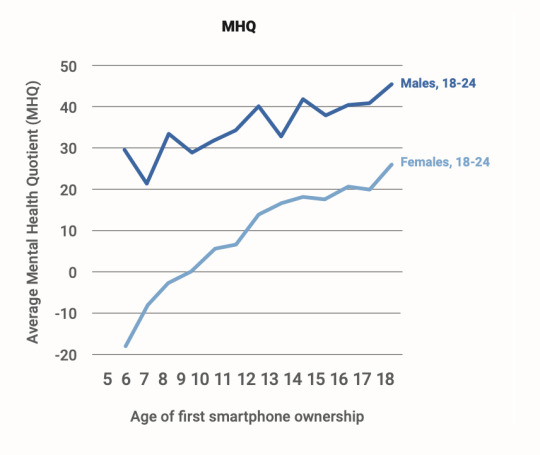
[ Figure 2. As age of first smartphone goes up, so does the mental health reported by young adults, assessed by the MHQ. Data from SapienLabs.org. ]
MHQ scores are calculated from responses to the 47 questions and converted to a scale that runs from -100 to 200, as shown here:

As you can see, the respondents who got their first smartphone before they were 10 years old are doing worse, on average, than those who didn’t get one until they were in their teens. The most mentally healthy respondents are those who did not get a phone until their late teens.1 You can also see that the slope is steeper for young women than for young men. The Gen Z women who got their first smartphone before they were 9 years old are in negative territory, on average.
The power and unique contribution of the Sapien Labs dataset come from two features of their work: First, they use a far more detailed measure of mental health than is used in most other large surveys. The second important feature is their international coverage. So, let’s zoom in and explore the six domain scores that make up the MHQ, first for the global sample, and then for the region and culture we know best: the Anglosphere.
2. Domains of Functioning
As you’ll see if you read the full report, the next step after examining the overall MHQ scores is to examine scores on the six domains of mental functioning:
Mood & Outlook: Includes items about optimism, calmness, anxiety, mood swings, sadness, and anger.
Social Self: Includes items about self-worth, relationships with others, empathy, cooperation, aggression toward others
Adaptability & Resilience: includes items about adaptability to change, ability to learn, and emotional resilience.
Drive & Motivation: Includes items about motivation, curiosity, enthusiasm, and addictions.
Cognition: Includes items about memory, decision-making and risk-taking, focus, and concentration, unwanted thoughts, hallucinations
Mind-Body Connection: Includes items about sleep quality, energy level, appetite, and physical health issues.
Figure 3 shows that for young women, all six domain scores show the same basic pattern as the MHQ: a consistent rise. You can also see that a few of the domains seem to rise more slowly or level off somewhat after the age of 13 or 14: Drive and motivation, Mind-body connection, and Cognition. However, the other three dimensions continue to rise all the way to age 18. The domain that rises fastest, meaning that it is most highly correlated with age of first smartphone, is the “social self” domain.

[ Figure 3: The 6 domains of well-being, for young women, as a function of when they got their first smartphone. From SapienLabs.org. ]
Figure 4 shows the same analysis for young men. The pattern is similar, with two important exceptions. First, the slopes are substantially lower, meaning that the mental health and well-being of young men are not as strongly related to the age at which they got their first smartphone as it is for their sisters, although it is still related. (All of the significance tests and effect sizes can be found in supplementary materials posted in this Google Drive link.2) The second difference is that all of the lines are higher for boys, meaning that boys are doing better than girls at all ages (at least, according to their self-reports). The one exception is that the line for Adaptability & Resilience reaches the same level for both sexes by age 18. Given the steeper slopes of all six lines for girls, this means that sex differences in adult mental health are larger among those who got a smartphone earlier.
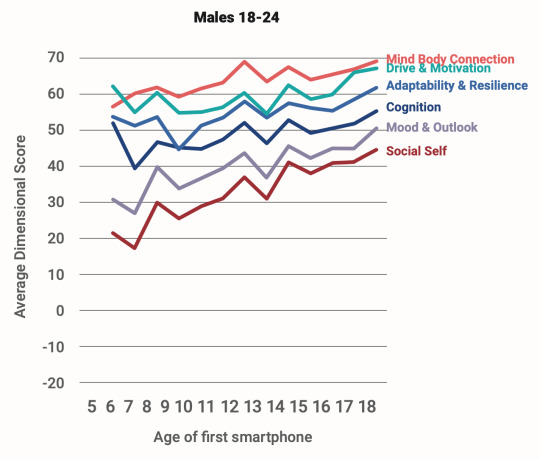
[ Figure 4: The 6 domains of well-being, for young men, as a function of when they got their first smartphone. From SapienLabs.org. ]
One major issue in analyzing an international dataset is that there are just so many differences between countries, regions, and religions that there are many opportunities for confounding variables to lead us astray. For example, in the Sapien Labs dataset, in the less wealthy countries such as India, few young adults had received a smartphone before the age of 10, which means that the data points on the left sides of the graphs contain almost no Indians, whereas the data points on the right side (no phone until 17 or 18) contain many Indians and fewer from the USA. If Indians are mentally healthier than Americans (for other reasons), this could cause the lines to slope even if smartphones had no effect on mental health. It is important, therefore, to look at individual countries and regions. (The Sapien Labs report does this in its appendix, where you can see that the trends hold for each of the world regions).
The region that we (Jon and Zach) know best and have written on extensively is the Anglosphere (the English-speaking countries of The United States, Canada, The United Kingdom, Australia, New Zealand, and sometimes Ireland). We, therefore, decided to examine what Sapien Labs had found about those countries and compare it to what we have found.
3. Zooming in on the Anglosphere
At the After Babel Substack, we have been documenting the patterns of rising mental illness among teens around the world, and, like Sapien Labs, we have found that the sudden decline of teenage mental health is an international phenomenon. Our research so far indicates that the increases in mental illness in the 2010s were slightly larger in the Anglosphere than in any other region we’ve examined. Figure 4 shows the large and sudden rise in self-harm rates among teens, particularly girls, in four of these nations (you can see much more in Zach’s initial report on the Anglosphere).
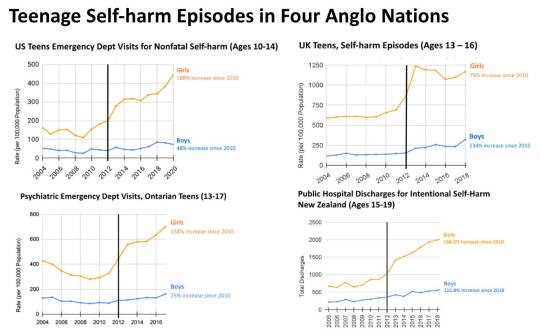
[ Figure 5. Since 2010, rates of self-harm episodes have increased for teens in the Anglosphere countries. For data on Australia and for all sources, see Rausch and Haidt (2023). ]
In every Anglosphere country, the mental health of teens declined sharply around the same time (~2012) and in the same way (depression, anxiety, and self-harm, with bigger increases for girls). We have also found that the five Nordic nations show similar trends, particularly when examining changing rates of depression and anxiety (though not always for self harm).
The Sapien Labs study began in 2019 so it cannot show us trends since 2010, but it can show us how young adults are doing today, and it can link variations in mental health today to variations in age of first smartphone. We wanted to get more familiar with the data and examine these links for ourselves, so we downloaded the full dataset as it was available on their Brainbase site on May 13, 2023, which was just about 2 weeks later than the dataset used in the Sapien Lab report. Our dataset contains 1,798 more participants, for a total of 29,767. The number of participants from the six anglosphere countries was much smaller: 1,465 (823 females, 584 males). By country: 682 in the USA, 297 in the UK, 224 in Canada, 239 in Australia, 10 in New Zealand, and 13 in Ireland.
We cleaned and organized our dataset in the same way as the team at Sapien Labs, with a small modification to account for our much smaller sample size. To reduce the jerkiness of the graph lines when we drop down to lower numbers of respondents for each point, we grouped participants into 2-year buckets (or three years, for our youngest bucket, 5-83). Figure 5 shows that the MHQ scores of Anglosphere boys and girls show patterns very similar to those reported in Figure 1 by Sapien Labs for the full 28,000-person international sample: The later the age of smartphone acquisition, the better the mental health. At least, that is true for the girls, all the way up to 18. For Anglosphere boys, there is a leveling off after the 11-12 mark. Delays beyond age 12 do not seem to be related to further increases in MHQ scores.4
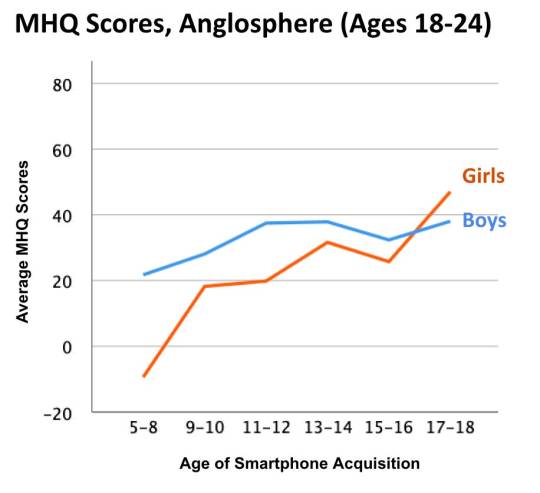
[ Figure 6. Anglosphere countries only: As age of first smartphone goes up, so does the mental health reported by young adults, especially for women. Data from SapienLabs.org, graphed by Zach Rausch. ]
We also plotted the six MHQ domain scores and found similar results. For females, all six dimensions of mental well-being improve as the age of smartphone acquisition increases.5 The effects are particularly strong for the “social self” and “mood and outlook”, which correspond well to the rise of internalizing disorders (depression and anxiety), which Zach has shown is rising within every Anglosphere nation.

[ Figure 7. Anglosphere countries only: female MHQ dimension scores. Well-being on all 6 dimensions increases as age of smartphone acquisition increases. ]
The trends for boys are similar to girls, though the effects are smaller and there is more fluctuation.6 Figure 8 shows that at the youngest ages, increasing age corresponds with improvements in each of the six dimensions. However, for boys, improvements tend to level off after age 12.

[ Figure 8. Anglosphere countries only: male MHQ dimension scores. Changes are smaller and more varied compared to females. ]
4. Limitations
It’s important to note that the report from Sapien Labs is one of their “rapid reports” made possible by their fast-growing number of participants and the easy access they offer to their data. They added the question about age of first smartphone in January and they are publishing a report, with data from nearly 28,000 participants, in May. We believe that this ability to move quickly is a public service during a global pandemic of teen mental illness. While their rapid report is not a standard academic publication and has not been through peer review (which often takes a year or more), the open access to the data has allowed us to investigate and confirm the trends they are reporting. We hope and expect that other researchers will download the dataset and offer critiques of the data, the analyses, and the conclusions drawn. This sort of “post-publication peer review” is becoming increasingly common as the problems with the existing peer review system become more widely known.
One issue to keep in mind with the Sapien Labs dataset is that the participants in each country are not a random or representative sample of the people in that country. Such studies would be extremely expensive to run, and now that so few people agree to phone solicitations or even answer their phones, it is unclear how representative such surveys can be. Those who agree to be interviewed, or who are motivated by money to participate, are not representative of the broader population. For this Sapien Labs report, participants came to the site on their own, or from online advertisements paid for by Sapien Labs, for the purpose of getting a detailed report on their wellbeing. So, the means reported for any country should not be treated like direct measures of the true means. However, samples such as these are still very useful for examining differences within the sample, such as those between men and women, or between those who got a smartphone early and those who got one late. And the much larger size of the Sapien Labs dataset, compared to Gallup and other survey organizations, allows for many additional analyses.
A second factor to keep in mind is that like all surveys, what we get is correlational data that is open to alternative interpretations. The graphs in the report are likely to suggest to most readers that getting a smartphone early causes later mental health problems. But with correlational data we must always consider the possibility that the causal arrow could run in reverse. In this case: having low well-being as a young adult could cause people to believe that they got a smartphone earlier than they did, but this seems unlikely. We must also always consider that there could be “third variables” that cause both of the first two variables to rise. In this case, one plausible confounding third variable is permissive parenting. Perhaps permissive parents (in each country) simultaneously do two things: they give their kids smartphones at very young ages, and they also give them few boundaries and little structure, which then interferes with development and produces struggling young adults. While this hypothesis is plausible and should be investigated, it is not clear how it would explain the fact that, in all the regions studied, it is the girls who show a tighter connection between early phone acquisition and later mental health problems, just as it is the girls who show a tighter connection between heavy social media use and concurrent mental health problems. Nor would it explain why mental health dropped so rapidly in the early 2010s (especially for girls) if permissive parenting (or some other variable about family life) was the real culprit.
And finally, we note that no one study is definitive, and more research is needed. We have been able to find a few other studies that examined the age at which children got their first smartphones (We have created a new appendix [8.14] in our collaborative review doc on Social Media and Mental Health). So far they are mostly smaller studies that have produced mixed results. If you know of any others, please add them to the doc or put a link to them in the comments below. We want to get this right.
5. Implications
We cannot be certain that the correlations shown in the data are evidence of causality, but we think it is appropriate for those who care for children to act on the preponderance of the evidence (which is the standard in a civil trial) rather than waiting for evidence beyond a reasonable doubt (which is the standard used in a criminal trial. See proposition 2 in this post.) There is increasing evidence that smartphones have a variety of detrimental effects on child development including reductions of sleep, focus, and time with friends in person, along with increases in addictive behaviors, so it makes sense that the cumulative effect of getting one’s first phone in elementary school would be larger than for those who don’t get a phone until high school. This is an important point made in the Sapien Labs report: The relationships they find suggest that there is a cumulative effect of having had a smartphone (and its many apps) over many years of childhood; they do not represent the effects of having used a phone a lot in recent days or weeks (which is the focus of most of the published research).
We think the implications for action are strongest for policies related to children and younger teens––those still in elementary and middle school (that is, age 14 and below) In most of the graphs in this post, including those for the Anglosphere, the slopes of the lines are steepest for those ages, and the links are visible for boys as well as girls (though smaller for boys). This concern to protect children before and during early puberty is consistent with a study published last year which found that in a large longitudinal study of British adolescents, the peak years for evidence of links between social media use and lower satisfaction with life were 11-13 for girls (which corresponds to the early part of puberty), while for boys (who begin puberty a bit later) it was 14-15.
On the other hand, the implications for action related to older teens and especially boys are less clear, at least within the United States and other Anglosphere nations. The lines for boys are somewhat flat in those ages, and the increases for girls generally slow down too. Furthermore, the arguments for why high school students need a smartphone (rather than an alternative, such as a flip-phone) are stronger than the arguments for why elementary and middle school students need one.
We, therefore, believe that the Sapien Labs findings should motivate us to think carefully about whether and when to give children their own smart devices, especially before high school. It is not the Internet per se that is harmful; so much of the internet is fantastically educational, useful, and entertaining. The most relevant questions, we think, are: 1) At what age do you want to give a child continuous access to the internet and social media, even when away from home, even when sitting in class? 2) At what age do you want to give social media companies, and other companies, continuous access to a child’s attention? And 3) does a child really need a smartphone when other kinds of phones (such as “flip phones” or Light Phones) work just as well for general communication (phone calls and texting)?
Implications for Parents
The group Wait Until 8th was founded to solve the collective action problem that parents and teens are in: Even if most parents wanted to wait until high school to give their children smartphones and social media, as long as most kids have those things by 6th grade, there will be enormous pressure on their children, and hence on the parents, to relent. Unless the parents can coordinate. So Wait Until 8th asks parents to sign a pledge, when their children are in elementary school, that they will wait until 8th grade to give them a smartphone. The pledge only takes effect once ten families in that child’s grade have signed the pledge so that the child will have a community of peers and will not feel so isolated before 8th grade.
We think this is a great idea, we just suggest that the pledge should be: Wait Until 9th. Or Wait Until High School. Children are usually 12 or 13 at the start of 8th grade; that is still within the period of early puberty. Plus, if 8th graders have smartphones, that means that smartphones will be everywhere in middle schools, increasing the desire of 7th graders to get them. To solve collective action problems, we think it’s best to focus on setting good norms within collectives (such as schools): make elementary schools and middle schools be smartphone free.
Parents understandably want to be able to reach their children when they are away from home, and a flip phone or other “dumbphone” is a very reasonable first phone that allows parents and children to reach each other. We suggest that parents not give smartphones as first phones. Let children learn to master a simpler kind of phone, one that cannot be loaded with addictive apps. Wait Until 8th offers an excellent list of the many smartphone alternatives.
Implications for Schools
Many of the teachers and heads of schools that Jon talks to are bitter about the effects of smartphones on their students and their school culture. They complain about the constant drama unfolding on social media during the school day. They complain about the distraction and the increased difficulty of getting students’ attention during class, since many students sneak looks at their frequently-buzzing phones, especially those sitting in the back rows. Many schools say that they ban phones, but what they often seem to mean is “the rule is that you can’t take out your phone during class.” That means that some students (the ones most suffering from phone addiction) will learn to do it stealthily, and many of the rest will just pull out their phones as soon as class is over, thereby missing out on face-to-face interactions with the students right next to them.
We suggest that schools consider going phone free, meaning that students can use their phones to arrive and depart from school, but once they enter, their phones (smart or dumb) would be placed in a phone locker, or in a lockable pouch. We think the case for doing this in elementary schools and middle schools is strongest. In a few weeks, Jon will write a substack post laying out the empirical evidence that smartphones distract students and disrupt education, even when they are kept in students’ pockets.
We also suggest that school districts collaborate with social scientists to do experiments on entire schools, rather than on individual students. What if a state or district identified 20 middle schools that were willing to cooperate, and then randomly assigned half of them to go phone free? There is no research of this kind that we can find, yet such a simple study would give us results within a single year that could potentially yield findings that improve both mental health and educational outcomes.
Implications for Legislatures
If there is a cumulative effect of smartphone ownership in childhood, and if the effect is due in part to heavy use of certain kinds of apps (such as social media) rather than other kinds of apps (such as watching movies, or using Wikipedia), then it becomes even more vital that we develop ways of age-gating certain apps and content. At present, US law sets a minimum age of 13 at which children can sign contracts with companies to give away their data (when they check a box on the terms of service). But the law was written such that the companies are not required to verify ages. As long as a child says that she is 13 or older, she’s in and can create a social media account.
This must change. If the minimum age were enforced, it would help parents solve their collective action problem, at least with regard to Instagram, Tiktok, and other social media sites for underage users. It is precisely Congress’s failure to enforce the age 13 rule that puts parents in the trap. Many states are now introducing legislation to remedy this omission. And there is one federal bill that does a particularly good job of focusing on age limits and age verification: The Protecting Kids on Social Media Act, introduced by Senators Schatz (D-HI), Cotton (R-AR), Murphy (D-CT), and Britt (R-AL). The act would “set a minimum age of 13 to use social media apps and would require parental consent for 13 through 17 year-olds. The bill would also prevent social media companies from feeding content using algorithms to users under the age of 18.” The bill also requires social media companies to develop rigorous age verification methods. (There are already many in existence, and many more would appear if the bill gets passed.) We also think the Kids Online Safety Act of 2022, introduced by senators Blumenthal (D-CT) and Blackburn (R-TN) would do a lot to make social media less damaging to children, and easier for parents to control. The fact that so many bills are bipartisan, at both the state and federal level, is a very encouraging sign in our polarized time. Legislators often report seeing the problems in their own children.
In conclusion: there is a great deal that can be done, individually and collectively, to address one of the top fears that parents express, about the safety and health of their children. The Sapien Labs data offers us new insight into the nature of the problem, and it alerts us that the problem may be global. It also guides us to the ages at which reform efforts are most likely to work.
--
POSTSCRIPTS (added on May 18, 2023)
1—We welcome additional and deeper analyses of the Sapien Labs data, and will post links here to such reports whether they support or contradict our analyses in this post.
2—One issue we should have discussed in the text is the inclusion of tablets, along with smartphones, in the Sapien Labs’ questionnaire. If their findings differ from those of other labs which asked only about age of first smartphone, then we won’t know whether part of the difference is the inclusion of tablets. We hope that future studies will ask about the two devices separately to figure out which devices are associated with harm at which ages (if any).
3—Some commentary online has made the important point that it’s not the phone itself which is harmful; it is the particular apps that the child uses, a child with a particular personality, in the context of a particular family that does (or does not) exercise oversight and apply restrictions. We agree. The original iPhone introduced by Steve Jobs was three devices: a phone, an iPod, and a web browser. Great! Three tools. Probably not harmful. It’s the addition of the app store that turned the smartphone into a portal to everything. If early acquisition of a smartphone is shown to be reliably associated with developmental problems, it would likely be because it enables continuous 18-hour-per-day access to hundreds of activities.
#Jonathan Haidt#Zach Rausch#smartphone#smartphone use#mental health#mental health issues#mental illness#depression#Sapien Labs#smart phone#smart devices#Mental Health Quotient#human psychology#psychology#religion is a mental illness
9 notes
·
View notes
Text
Stay Updated with Top Hindi news live updates in India from Oneindianews
In the fast-paced world of news, staying updated with the latest happenings is crucial. Top Hindi news live updates in India from Oneindianews for Hindi-speaking audiences. Oneindianews is a premier destination for Hindi or Gujarati breaking news that offering comprehensive coverage on a wide range of topics. Whether it’s politics, sports, entertainment, or world events, Oneindianews ensures you are always in the know.
Comprehensive Coverage
Oneindianews provides in-depth reporting on current events. The channel's team of experienced journalists works tirelessly to bring you accurate and timely news. Their coverage spans across various domains, including:
We deliver the National news portal, Breaking News, live updates from India and around the World. It gives you Breaking stories, in-depth analysis & expert opinions.
Crack the competitive exams with our latest current affairs and other education news in India from Oneindianews. Get Hindi and Gujarati topic related current affairs and science, political, financial, entertainment etc.24/7 hours.
Our channel is top local Gujarati news channel from Oneindianews. It brings top Gujarati samchar, National and International Breaking News, Today News Headlines in Gujarati language and much more.
Step into the spotlight with Oneindianews, Gujarat premier entertainment news channel. We bring you exclusive interviews, behind the scenes peeks, and juicy updates on your favorite stars, keeping you in the loop of all things filmi.
Get top Elections News, Political News, Videos and Photos in Gujarat from Oneindianews. Read all the breaking Gujarati samachar, news headlines, top stories, videos and photos about Gujarat Elections.
In today's fast-paced world, staying informed about the latest news is more important than ever. With so many news channels and websites available, it can be challenging to find a reliable source that provides accurate and timely information. Oneindianews.com is a leading news website that has made its mark by offering comprehensive and up-to-date news coverage, especially in Hindi.
ગુજરાતી સમાચાર, Top Gujarati news live updates in India from One India News. Get the latest headlines, updates, and stories in Gujarati Language and more by 24/7 hours.
Find here latest finance news, business news, live stock market news, IPO update, banking and insurance sector updates from in Oneindianews.
हिंदीसमाचार, Top Hindi News live updates in India from Oneindianews. Get the latest headlines, live updates, and stories in Hindi language and much more by 24/7 hours.
In the fast-paced world of news, staying updated with the latest developments is crucial. For the Gujarati-speaking population, having access to reliable and timely news in their native language is not just a convenience but a necessity. This is where the Gujarati National News Portal from Oneindianews steps in, bridging the gap between global happenings and local perspectives.
One India News brings the latest top international headlines news, Current International breaking news worldwide and also covering politics, conflicts, diplomacy, and much more in your languages.
Real Time Updates
Oneindianews stands out for its commitment to providing real-time updates. The 24/7 news cycle ensures that you never miss an important story. With breaking news alerts and live coverage, you can follow developments as they happen. This immediacy is particularly crucial during times of crisis or significant events, ensuring that you have access to the latest information when it matters most.
User Friendly Interface
The website, oneindianews, is designed to offer a seamless user experience. It is easy to navigate, allowing users to find the news they are interested in quickly. The homepage features the top stories, and various sections cater to specific interests, making it simple to explore different categories of news.
Engaging Multimedia Content
Our news channel doesn’t just rely on text based articles. The channel offers a rich multimedia experience with high-quality videos, photo galleries, and infographics. These elements enhance the storytelling, providing a more engaging and informative experience for the audience.
Social Media Presence
Understanding the importance of social media in today’s digital age, Oneindianews has a strong presence on platforms like Facebook, Twitter, and YouTube. This presence ensures that you can stay updated with the latest news on the go, receiving instant notifications on your preferred social media platform.
Reliable and Trustworthy
In an era of misinformation, Oneindianews prides itself on being a reliable and trustworthy news source. The channel adheres to high journalistic standards, ensuring that the news delivered is accurate, unbiased, and verified. This commitment to truth and integrity has earned our news the trust of its viewers.
Conclusion
For top hindi news live updates in India from Oneindianews a reliable source for an excellent choice. With its comprehensive coverage, real-time updates, user-friendly interface, engaging multimedia content and strong social media presence ensures that you are always informed about the latest happenings. Stay connected with Oneindianews to navigate the world of news effortlessly.
#Breaking News#live updates from OneIndianews#Breaking Education news from Oneindianews#Top News Channel Gujarat from Oneindianews#Entertainment News Gujarat from Oneindianews#Latest Election and Political News in Gujarat from Oneindianews#hindi and gujarati language news live updates from oneindianews#live updates#local news from oneindianews#top Financial News#Business News#Market News in India From Oneindianews#Top Hindi news live updates in india from Oneindianews#gujarati breaking news portal from oneindianews#Top International headlines news from OneIndiaNews
2 notes
·
View notes
Text
Stardust
Our relations define us. Our life is a product of who we meet, know, or live with. It has been 955 days and 22,920 hours since I posted my first blog post here. It is now time for a small revealer.
I was not even in middle school when my Nani (maternal grandma) passed away. To be truly honest, I never came to understand her properly. When she was running behind me, I was busy enjoying my new world out of mom's uterus, and when I got some sense, she said goodbye. So she was 'Neelam.'
But this blog isn't about her. It was never about her. She wasn't a poet, writer, or a philosopher. And she did not possibly teach me any of the things I write here on Tumblr. Then what did that old lady do that she has her name written right on the top?
'Vaahini' in Hindi means channel. And my pretty granny decided to make me a delicate channel. So, some stardust was sprinkled on me by my grandma (who is possibly enjoying a glass of wine with the Gods now). And that canon event has led to all the beautiful writing I do. My Nani gave birth to my mother, but that is not too big of an accomplishment.
Nani, you still deserve a million thank yous, and well yes a blog by your name for doing something magnificent. Thank you Nani for raising a girl who is much more than my mother.
PS: She is not at all like you and does not make better food as well.
Thank you Nani for making me fall in love with the festival- Janamashtmi. It was because of you that I dressed up as Radha and sang in my very horrible voice a famous Bhajan dedicated to Lord Krishna.
As a writer, I have had many Eureka moments, and I know that it is your stardust that brings me all those values you couldn't give me in your lifetime.
On a slightly different note...
We go to Uttarakhand every year. Every year it is. My mother loves it and now I have to love it too. I have literally visited every inch of this state. From Haridwar to Chamoli and from Dehradun to Nainital, there is beauty, beauty, and beauty. Aesthetic, spiritual, and cultural beauty. Too much beauty and altitude make me dizzy. But when you know it is the comfort destination for your mother, you end up loving even the mischievous monkeys that reside in every temple’s corridor. Believe it or not Mom, today when I am getting accepted by universities abroad, I understand why the snow in Uttrakhand is gold.
My mother has taught me what a family is. I can’t possibly say that we are the best family in the world because the life I am living with them is the only life I know about. And I can't possibly say that Mom you are the best mother because you are the only mother I have ever had. Plus that would be unfair to Nani. But what I can say is that I am the best version of myself today because I have you.
Happy Birthday Mumma!
This blog isn't the best description of you because you know you are not the best mother in the world.

Nani, you have to help me choose. Which bhajan from your abundance am I supposed to sing next?

I greet the divine within you-"Namaste"
#neelamkishabdvaahini#words of mine#words#words that matter#life#poetic#writer#writing#writer on tumblr#family
10 notes
·
View notes
Text
Caught Up To The Heavens - The Esoteric Santism of the Tulsi Sahib Satsang - Spiritual Awakening Radio Podcasts

Mystic Poem of Sant Tulsi Sahib of Hathras: Within This Body:
"Within this body breathes the secret essence.
Within this body beats the heart of the Vedas.
Within this body shines the entire Universe, so the saints reveal.
Hermits, ascetics, celibates all are lost, seeking Him in endless guises.
Seers and sages perfectly parrot the scriptures and holy books, blinded by knowledge.
Their pilgrimage, and fasting, and striving but delude.
Despite their perfect practice, they discover no Destination.
Only the Saints who know the body's heart have attained the Ultimate, O Tulsi.
Realize this, and you've found your freedom
(while teachers trapped in tradition know only the mirage in the mirror)."
Spiritual Awakening Radio Podcast - Caught Up to the Heavens, The Esoteric Santism of the Tulsi Sahib Satsang @ YouTube:
https://youtu.be/6sMtylkVov8
Spiritual Awakening Radio Podcast - Caught Up to the Heavens, The Esoteric Santism of the Tulsi Sahib Satsang - Listen/Download @ the Podcast Website:
https://SpiritualAwakeningRadio.libsyn.com/caught-up-to-the-heavens-tulsi-sahib-and-the-gnostic-saints-of-india
Listen @ Apple Podcasts:
https://podcasts.apple.com/us/podcast/caught-up-to-the-heavens-tulsi-sahib-and-the/id1477577384?i=1000612594155
Follow @ Apple Podcasts:
https://podcasts.apple.com/us/podcast/spiritual-awakening-radio/id1477577384
@ Spotify:
https://open.spotify.com/show/5kqOaSDrj630h5ou65JSjE
@ Google Podcasts:
https://podcasts.google.com/feed/aHR0cHM6Ly9mZWVkcy5saWJzeW4uY29tLzIwNzIzNi9yc3M
& @ Wherever You Subscribe and Follow Podcasts (YouTube, Apple, Spotify, Google Podcasts, Amazon, Audible, Stitcher, PodBean, Overcast, Jio Saavan, iHeart Radio, Podcast Addict, Gaana, CastBox, etc...):
https://linktr.ee/SpiritualAwakeningRadio
Today during this Satsang Without Walls some rare passages from the world of esoteric Santism translated from Hindi, the writings of Sant Tulsi Sahib of Hathras, India and a few of his spiritual successors on this Path of the Masters, Inner Light and Sound Meditation, the Way of the Soul Merging into the Heart of the Beloved, the Ocean of Love in the Nameless Plane (the Anurag Sagar of Sat Purush Anami Radhasoami).
"Only by breaking the bonds of mind, illusion and time is one free from the cycle of transmigration." (Sant Prakash Das)
"Complete Mahatmas, Genuine Saints came to the world in their respective times and kept on emancipating the living beings who were connected with them. On completion of their time, they left the body as per the will of the Lord and went to the Lord and left their work [their spiritual mission] to the other saints when departing." (Sant Prakash Das)
"The true master practices the spiritual Sound and Light that comes from beyond. By these methods of meditation, the soul becomes introverted through regular practice and hears the melodious Sound within, and the soul reaches where the Sound is emanating from. This is the goal of the practice of Surat-Shabd-Yoga." (Sant Prakash Das)
Like Galileo discovering new worlds through the lens of his telescope, mystics of the East and West (Jewish mystics, Christian Gnostics, Sufis, and in modern times, the Sants and Radhaswamis of India: Path of Sant Mat) have been trying to tell humanity for eons of something quite similar... about another kind of space... Inner Space. The reason why the contemplative state of being is still hidden from most of us is that, unlike Galileo’s telescope, in order to look through this particular lens, we mustn’t focus on the outward sensory impressions, but go in the opposite direction: into Inner Space. Look through the lens of the third eye to access the world of within. But one has to be willing to take the cap off the lens and have a look, to actually do the meditation. If we do follow the methods of meditation practice revealed by the Masters, with the third eye we will behold the Inner Light, Inner Visions, hear the Sound of Silence, the Holy Stream of Sound -- Music of the Spheres, traverse the heavens for ourselves, and return home to the Beloved Lord of Love, the Lord of the Soul.
In Divine Love (Bhakti), Light, and Sound, At the Feet of the Masters, Radhaswami,
James Bean
Spiritual Awakening Radio Podcasts
Sant Mat Satsang Podcasts
A Satsang Without Walls
Sant Mat Radhasoami
https://www.SpiritualAwakeningRadio.com
#wordpress#tumblr blog#podcasts#youtube#apple podcasts#spotify#google podcasts#spiritual awakening radio#satsang#sant mat satsang podcasts#james bean#spirituality#meditation#india#gnosticism#mysticisim#mystics#sant tulsi sahib#kabir#anurag sagar#sant mat#radhasoami#inner light and sound#soul travel
15 notes
·
View notes
Text
महिला को बुजुर्ग मां से मिलने जाना पड़ा भारी, पति ने कमरे में बंद करके गर्म चिमटे से दागा; देखें वायरल वीडियो
महिला को बुजुर्ग मां से मिलने जाना पड़ा भारी, पति ने कमरे में बंद करके गर्म चिमटे से दागा; देखें वायरल वीडियो #MeerutNews #MeerutEntertainment #LocalNewsMeerut #MeerutUpdates #MeerutTrending #MeerutCommunity #DiscoverMeerut #MeerutReports #MeerutDiaries
Meerut News: एक दिल दहला देने वाली घटना में, मेरठ के एक शख्स ने अपनी पत्नी पर क्रूरता की सारी हदें पार कर दीं। मामला तब सामने आया जब पीड़ित महिला अपनी बुजुर्ग मां से मिलने गई, जिसके बाद पति ने उसे कमरे में बंद कर दिया और गर्म चिमटे से उसे बुरी तरह से जला दिया। घटना मेरठ के एक कस्बे की है, जहां पीड़ित महिला अपनी मां से मिलने के लिए गई थी। हालांकि, जब वह वापस आई तो उसके पति ने इसे अपनी मर्दानगी और…
#burnt#crime in meerut#elderly mother#fire in meerut news#hot tongs#Husband#latest meerut news#latest meerut news in hindi#meerut#meerut crime#meerut crime news#meerut fire news#meerut hindi news#meerut hindi samachar#meerut latest news#meerut murder#meerut news#meerut news in hindi#meerut news live#meerut news today#meerut news up#meerut news update#meerut news video#meerut police#meerut police news#meerut today news &039;#meerut viral news#meet#murder in meerut#vande bharat meerut
0 notes
Note
for the ask game, 20 and 7? And also, u don't have to answer but I'm curious how u would change India's characterization/how u would improve on it :0
Hey babe, Hetalia ask game dropped!
Thank you for the ask! Sorry for this being so so late sahdk
20) Answered here
7) Food-related headcanon? (im hungry)
India: I definitely think he'd be a sucker for spicy food. But I also think he'd absolutely love extremely sweet food. This is based on personal experiences, but Indian food has a extremely sweet to extremely spicy side lol. For example, some foods that are on the wayyy too sweet side for me personally are Barfi, Jaleebi and Kesari (I do enjoy them tho lol). So, I think that India definitely cares a lot about the favor and experience the food gives a person :)
As for India's characterization! Ok, I've been thinking about this since the day you sent me this ask lol and I really hope you don't mind but the first bit is a bit rant-ish to clear up some misconceptions.
So first thing I really want for people to understand India is that, it is not just the North. There is no 'dominant' culture, and Hindi is spoken as more of a connecting language more than like- a first language by a lot of people that live in places other than what I like to call the "Hindi Belt"
1)The Idea of Northern Culture as a 'dominating' culture does not make sense and kinda erases the other cultures that live and very much thrive in India today. If you went and only toured around North India, you would see a huge difference between cultures up there alone! I understand that this idea that Northern Culture dominates India is from the wide spread knowledge of Bollywood. But India's really diverse! We even have a lot of film industries for each language! Tollywood, Kollywood, Mollywood, Sandalwood, etc. But, I'm getting off topic, Northern Culture does not 'dominate' the majority of Indian Culture, and Northern Culture itself is very hard to define because it's diverse! From Rajistan to Punjab, the cultural differences are very different in the north, so imagine the differences from north India to the south- not even accounting for the tribal cultures in each state!
2) Most Indian languages stem off of two language families: Indo-Aryan and Dravidian and if you look on a map of language families, you can almost see a clear line between these languages. Within those branches, stems of languages, a lot of them are still spoken today. So making Hindi the only language India speaks doesn't make that much sense to me and erases literally every other culture living and very much thriving today!
How I'd Improve it in the Anime
For an Anime that's portraying nations based on stereotypes, I would say- it could be worse lol. I do get why Hima portrayed India like that, I mean it's not as bad as some other media I've seen that portrays India as: "Taj Mahal, Snake charmers, Tiger, Elephant, Elephant, Middle Eastern Culture for some reason". So for a anime about stereotypes it's not that bad lol. There's maybe like two things I'd change?:
-Make India a little more easy to anger than easy going. I guess hetalia is about stereotypes and the stereotype is that Indians are very "Yoga, Buddhism/Hinduism, Rangoli" not about actual cultural stuff of characters, but yeah I'd probably make him a little bit more of a hot head lol
-Make him appear more in the anime/manga!! He only shows up like three times and usually in background roles, micro-nations show up more than him T-T
My Own Characterization
Some positives:
Kindness: I feel like India is very generous and nice to everyone he meets. When he meets a new country or person he usually tries to be as nice and respectful as he can with them before forming an opinion about them. I'm just basing this off of age. I feel like at a certain point (as with most ancient nations), he realized that country's relationships with each other are very unexpected and so he tries to start off on a good note.
Emotionally Resilient: This might be a given because he is a nation lol, they've lived a long time and can adapt to unexpected situations really easily. I also feel like because he's an ancient, he still feels those knee-jerk emotions/reactions but it takes more to trigger them if that makes sense.
Makes Connections Easily: A large part of Indian culture, is family and community. Families, back then often lived in one house. Often with an opening in the middle where the family hangs out or lived in a community of houses close to each other. So I definitely feel like he gets close to people very easily and often treats them as family.
Flaws:
I feel like in his early years India would have been easy-to-anger and have some amount of arrogance? It's just two traits that I've seen amplified, if not glorified, by Indian movies because they're seen as very masculine traits to have (in general).
Easy-to-Anger: Because of how long India's lived, I feel like he has a lot more patience now days but certain topics or someone being insistent might make him quick to anger.
Arrogance: I feel like arrogance is something all nations have, it's a given, but again, time and experience wears it down. So, I feel like compared to other nations, he's more down to earth, but still pretty arrogant.
Stubborn: He is stubborn, he protests heavily for the the things he believes in and does not stop until he gets his way. He can remember something that someone said centuries ago and continue to do something just to spite them.
General Headcannons:
He loves Dance, Music and the Arts: In India, Classical Dances are very important. It was used for entertainment, religious purposes and also used for storytelling! There are some that are similar to theater, there are dancers telling the story of a mythological event, dances that are related to gods, or dances that were simply made to entertain royals.
And regional music where do I start! Indian music is diverse, and there are a lot that I could mention from my state alone! There are different rhythms, elements, instruments, different focuses, and sometimes you'll clearly hear some outside influences with the music styles! I just absolutely love the idea of India dancing, and singing because it's such a huge part of culture
Loves Science: I really think he does have a thing for science, not only because of the recent interest of science in India but also because of how much Ancient India contributed to science! I think he would go to a lot of science/math conferences nowadays to meet scientists/mathematicians and learn about new theories and technologies.
India's doesn't really have a name: This is just a personal headcanon of mine lol and not really based of anything in particular. I HC that India didn't really have a name throughout history, and he changed it often depending on where he was and names of the time period. I think it's because of the difficult question is "what is India/Indian culture and what is its one and true descendant?". The answer could be many things. How do you define the culture of a nation that has a lot of cultures in it? Thus, how do you choose a name for a country when that name doesn't make sense for him to have in other parts of the country?
Gender, Religion, Identity: I think India identity's very fluid, and he doesn't label himself. I really liked how @thegoliathbeetle phrased this in her post! India's identity is like water, it shifts, transforms and changes. It doesn't stay constant and if you ask him who he is he would give you a different answer depending on the time and place. (I really agree with her post and I would def check it out if you haven't!)
#This was really fun! I did kinda rant a lot- so really sorry about that lol#aph india#hws india#other hetalia stuff#asks
13 notes
·
View notes
Text
Travel Sketches (Nov 2023 - March 2024)
Nov 2023.
Bishnumaya just turned 100 this October. She comes from Pokhari, about 15 kilometers from Mirik town. As we spoke, she recalled old memories, her expressions shifting as if reliving those moments. She seemed elsewhere, gazing past me into the distance, and then, as if continuing a conversation with herself, she said, “Nowadays people ask about caste when they meet someone, and how is that of any use?”
She described how, when she was small, there were no proper schools in her village. She learned to read and write, however little, by arranging corn kernels on the ground to form shapes that resembled letters and numbers. Reflecting on her long life, she added that everyone around her—friends her age and younger siblings—is dead, and she feels like a monster who swallowed them all.

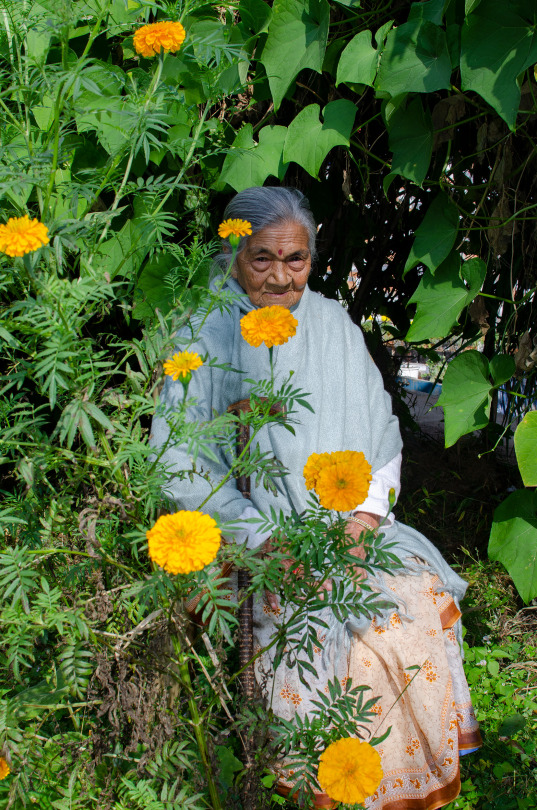
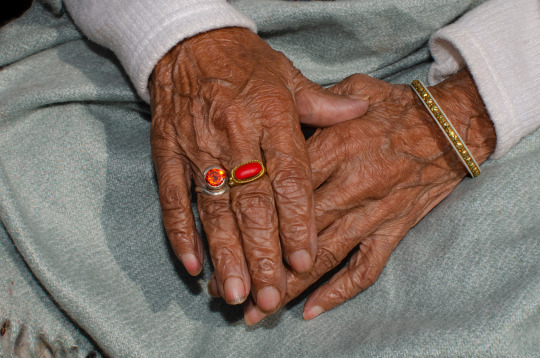
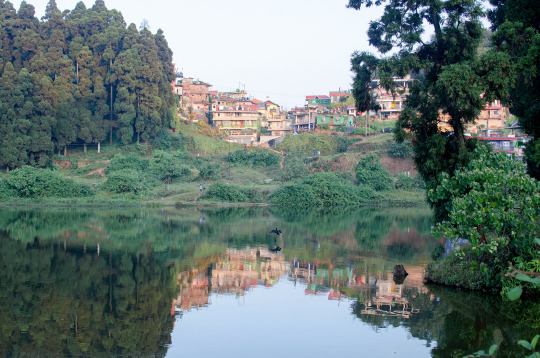
The sun is out, but it’s only warm where the light falls. The history of Mirik is reflected in its lake, which used to be a marshland. According to Wikipedia, the name Mirik comes from the Lepcha words Mir-Yok, meaning "place burnt by fire." It's very green now for a place that was once burnt.
A town fair is underway, offering a range of attractions: a Ferris wheel, flower park visits, fast food stalls, ice cream carts, horse and boat rides, live pop music, card game betting, balloon shooting, local bingo-type card games, and hoopla with prizes up for grabs. Some prizes are cash with notes of 20, 50, and 100 rupees.
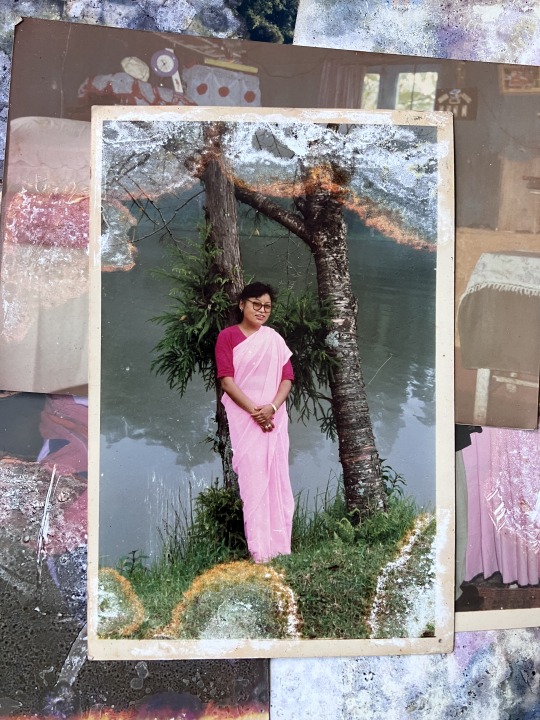
——
For the past ten years, I haven't had a permanent home. When I wanted to sidestep the weight of planning and longed for comfort and familiarity, I returned to places I liked a little more than others: Auroville, Dharamshala, Shillong, Aizawl, Nagaland.
I like meeting new people and have formed what feels like extended families in some of these places. Since I have mostly felt free to move around, sometimes nostalgia of people or a time or a curiosity to see how things may have changed would draw me back to a place.
Earlier in August, while I was temporarily living in Auroville, I got a call about a six-month project called The Great Himalayan Exploration, a collaboration between UNESCO and Royal Enfield. The project aims to document the intangible cultural heritage of local communities in the Himalayan region of Northeast India.
My work on this trip specifically involved photographing the people behind various cultural practices and examining the ecosystems they exist in. To build context, I engaged in various methods, such as scanning old photos from people’s personal albums, taking photos of their living spaces, landscapes, and exploring archival resources. From November to April, we were in West Bengal, Sikkim, Tripura, Mizoram, Assam, Nagaland, and Meghalaya.
------
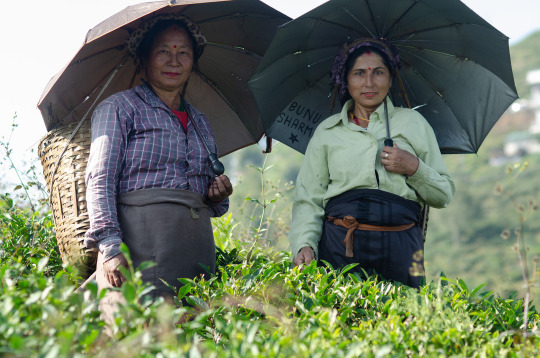
On our way back to Siliguri from Mirik, we made a lengthy stop near a tea estate. Lalita, from Tingling village, shared that she had spent two decades working on the estate, much like many other women from the village. Their collective hope was to earn a minimum of 500 rupees per day for their labor. Currently, they are receiving 250 rupees per day for an eight-hour shift.
------
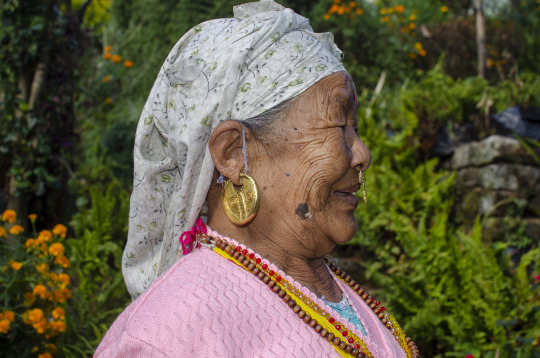
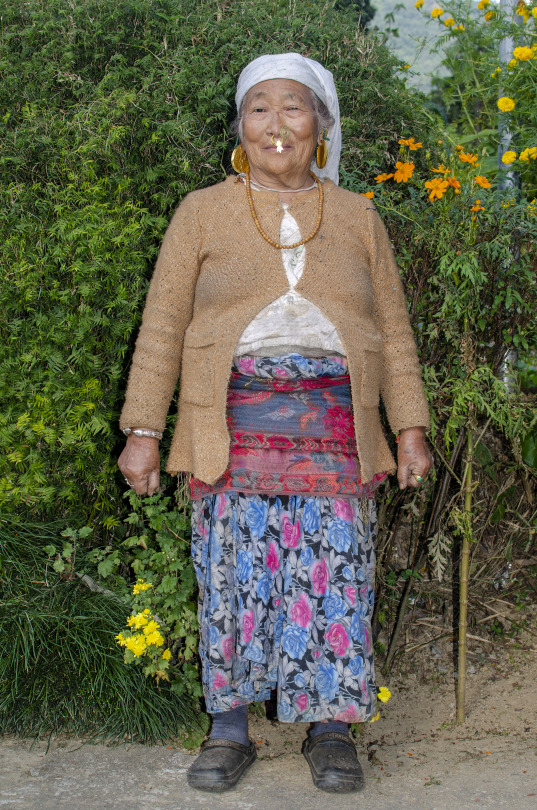
Sanchamaya, 74, sits with her friend Bodhimaya in the front yard of her house in Darap, both lifelong farmers of the area and belonging to the Limbu community. They're nice and welcoming. It's our second day in Pelling, West Sikkim, and I've ended up at the wrong house. Today, we're supposed to see a drum dance(chyabrung) performance by local Limbu boys, which I'll catch later.
They talk in basic broken Hindi, with Shusan translating most of it. Sanchamaya leads me to the back of their house, where she proudly shows me trays of dried large cardamoms. Later, we'll visit her cardamom field. They also cultivate Mosambi, oranges, guavas, maize, peas, ginger, and onions. Sanchamaya spends her days with her friend, grandchildren, working in the fields, and cooking in the kitchen.
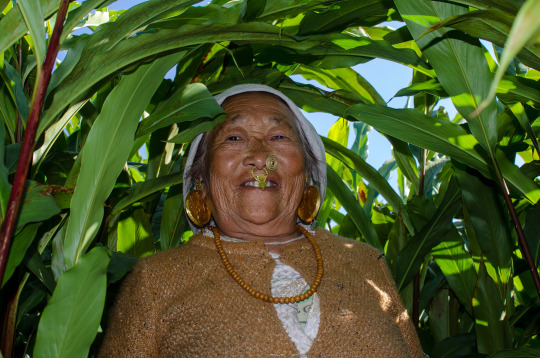

------
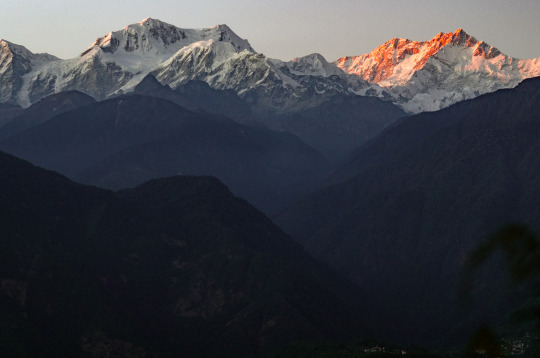
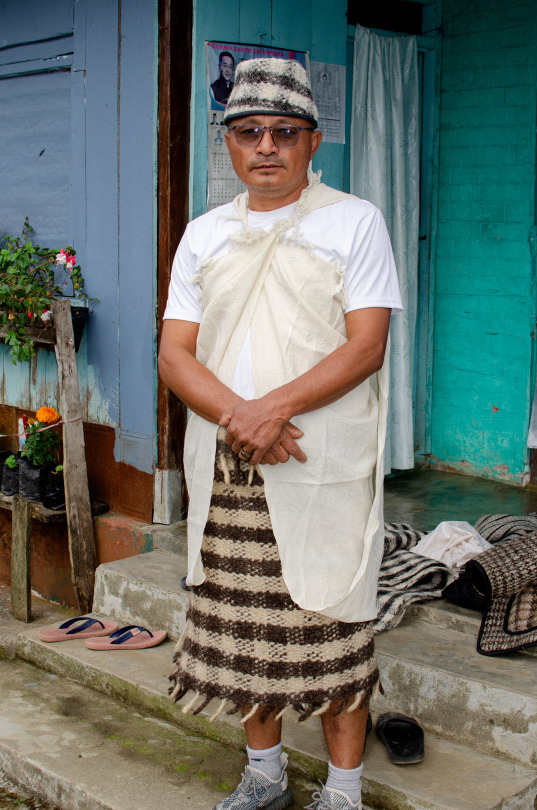
I visited Chuba village, 3 hours away from Gangtok, with Semeon from Haflong, Assam, a textile design graduate from NID and working at Sonam’s design studio called EchoStream based in Gangtok. Semeon was familiar with the village and the community I was there to meet. Arun Gurung and his wife, founders of Chubako, are endeavoring to revive an old tradition of sourcing wool from indigenous banpala sheep to make clothes. They operate a small cooperative called Chubako. In this village of 43 families, one person from each household now works for Chubako. (photo above: Arun Gurung, founder of Chubako)
(photo below: Designed by Sanskruti Shukla, co-created with the craft community of Chubako for Echostream, Gangtok)
Local stories of the craftspeople of Chuba are showcased and incorporated into wool through interactive workshops focused on storytelling and design development. The felted art rugs depict the flora and fauna of Sikkim.



Gangamaya Gurung, 83, Arun Gurung's mother, lit up like a child when she saw Semeon. They shared a bond akin to best friends. Despite her age, Gangamaya remains active, tending to sheep, cutting grass, farming, and weaving. When asked about her leisure activties, she said, "eat, watch TV - eat, watch TV."
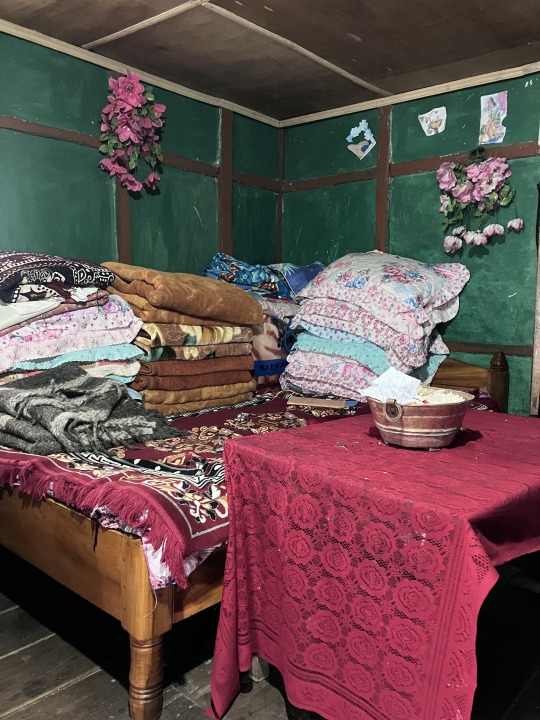


Sampati Debbarma, a farmer, returning from work in Takarjala, Tripura.
--------
Jan, 2024.
We have been out on this trip for 3 months. My thoughts scattered in a kind of bardo between the world I know and the world I am coming into contact with. I picture house fronts with flowers in Darjeeling, roads winding, the long cold rivers snaking toward mountains that seem no bigger than my thumb, the snow capped peaks shifting colours, the prayer flags in high altitudes and on house doors. Gangtok’s Lal Bazaar skateboarders flash by, a school in Tripura where a student lives on 700rs a month, nini bung tamo and 4 other sentences I learned in Kokborok nag me like a tune. Sidangcherra to Pecharthal to Panisagar to Damchara checkpoint we make our way from Tripura into Mizoram by road. I think about where I will be later in the summer and see a white fluffed cloud taking the shape of a growing tree far on the horizon.
——

Krismas Ruaitheh(Christmas feast) at Khatla Presbyterian Church, Aizawl. This is my 3rd time in Aizawl. I used to go for dinners, sometime evening tea to my friend’s family house further up the road from the Khatla church. We are here to document the traditional community feast of the Mizos.

Priscilla is currently pursuing her BA in Political Science in Delhi, and she's home for the holidays. She was volunteering at Khatla Presbyterian Church where she and her friends were tasked with serving lemonade, a customary drink after the meal. For Priscilla, the most remarkable aspect of the feast is its longstanding tradition — dating back to pre-Christian times — where the entire community comes together to share its moments of joy and sorrow + they still use Changel Hnah (plantain leaves) — the traditional way to serve meals.
-----
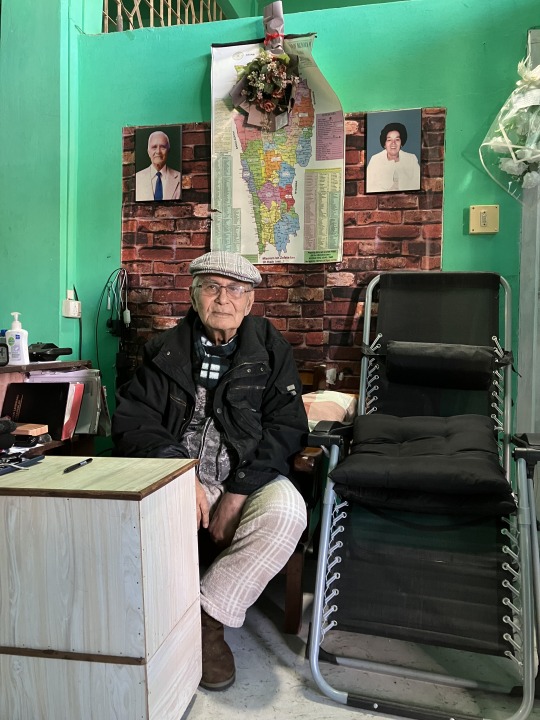
On an idle walk one evening in Khatla, I find myself in a local thrift store and get invited to meet James Lalhmingliana. He is 80, one of the founding members of Aizawl's first bike club, Aizawl Thunders. He went to school at Sts. Edmund’s in Shillong.
In 1966, he joined the Mizo National Front uprising, fighting for freedom. He went underground for seven years, first in Arakan, Burma, then in 1969 to East Pakistan for shelter. "It was useless," he says. "We wasted our good years. When I came back, I was put in jail, but not for long."
He has been housebound for years due to his health.
———


At 8 am on a cold January morning, we arrive at Joonbeel Mela. (Joon and beel are Assamese terms for moon and wetland. The Tiwa community first organized this in the 15th century to exchange goods between indigenous tribal communities in Assam and the surrounding areas.)
It is known as the only fair in India where people still practice barter, exchanging goods like fish, sweet potatoes, yam, homegrown vegetables, turmeric, chili, kali miri, and rongalau.
Over a few hours, I have brief interactions with people from Jagiroad, Pamlatar, Deosal, Sira, Changsari, Potia Pathar, Bengenabari, Palahguri, ulukunchi, morigaon, Nagaon, Saru Amli, Belguri, Damal, and places as far as Langpih, mawlynnong in Meghalaya. No one refuses a photo.
—

This is my fifth time in Nagaland. I first came here ten years ago and stayed at Kevesho's home. He is the father of the Tetseo Sisters, a well-known folk group of four sisters from Nagaland.
Kevesho Tetseo, son of Nülhüprü Tetseo was born in 1950s in Thüvopisümi village, Phek District, Nagaland. Initially schooled in the village, he finished his HSLC at Government High School in Kohima and graduated from Kohima College in Arts. He worked in the Education Dept. for sometime and now retired. Active in cultural music, Chokri language preservation, and in church choir since his youth.
(Tati - - a single string musical instrument which is used as an accompaniment with singing of li- indigenous songs by the Chakhesang Nagas.)
Kevesho learned how to make Tati from observing elders in his village when he was young and has done Tati making work since 1990s and a good number of it has been produced till date by him including improvising it for longer life by using steel wires as strings.
He tells me, the woven shawl he is wearing in the picture is "thipiqhü". It is the most prestigious shawl (indigenous cloth) among many traditional clothes of the Chakhesang tribe. It is a shawl they wear with humility and honour.
“Nagaland is my home and I love my culture, its rich traditional heritage, and the natural beauty.”
-----
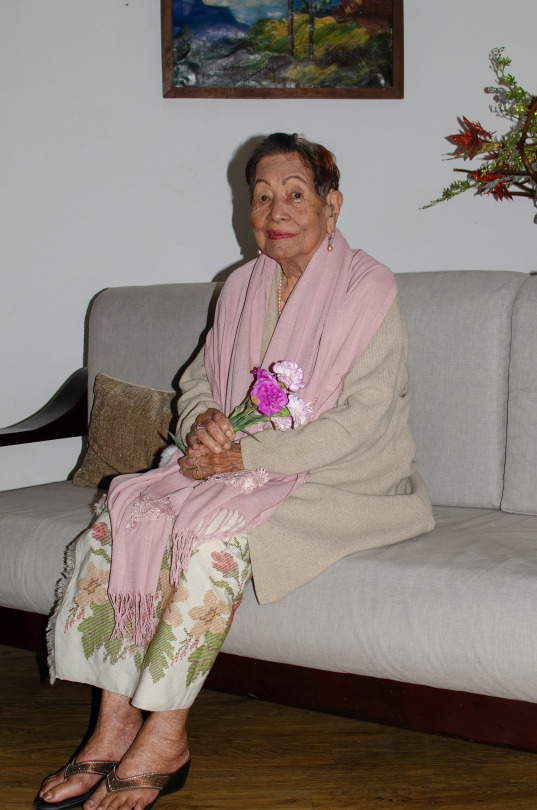
Daisy Yaden was born in Zotlang, Mizoram. She studied at the Welsh Mission School in Mission Veng, Aizawl. She will turn 98 this June. She learned to weave shawls on a backstrap loom, stitching, and baking from her mother, often baking cakes in the fireplace. She taught in the interiors of Nagaland, in places like Noklak and Changtongya. She started her career by teaching people self-sufficiency—how to cook, make jams and pickles—skills she picked up from a British magazine called Woman’s Own. She used to compose little tunes for children at Sunday school. She loves flower gardening and her favourite film is "Gone with the Wind."
Photographed at her house in Duncan, Dimapur.
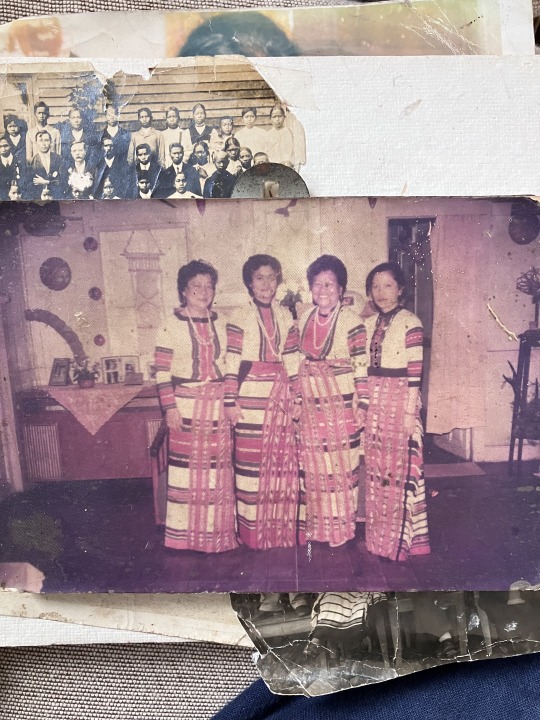
I am sitting with Marian, Daisy's daughter, at her house in Duncan. Marian, now 75, lived in Bombay from 1970 to 2012. She went to college there and worked as an air hostess with Air India for 34 years. In 2012, she returned to Nagaland. We agreed to meet again for lunch and look at her old photo albums.
(below: Marian,16, in Kohima trying a sari for the first time / in Santa Cruz, Bombay in the 80s with James Ferreira and friends)
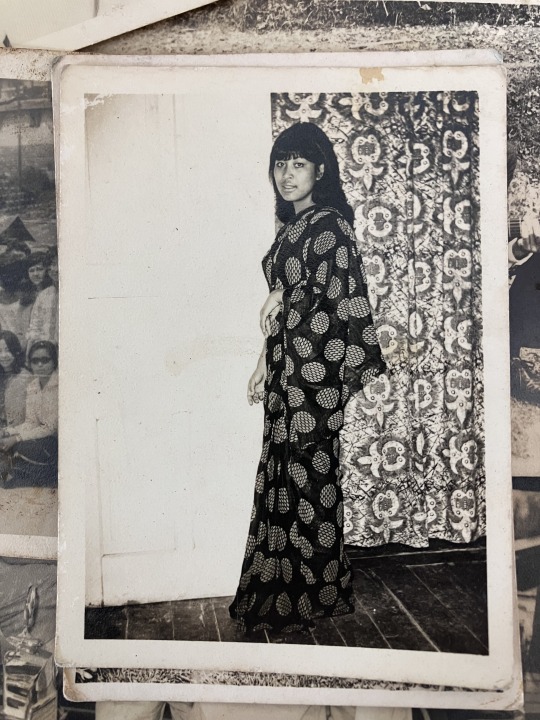


——-
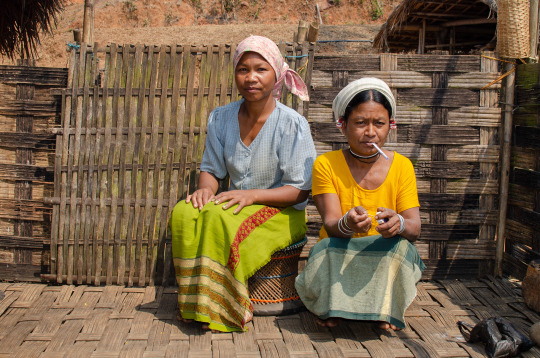
Khinchi is Christian, and Sindri is Songsarek, belonging to one of the last animism practising communities. I learned a few words in Achik: Khading bo, Methela, Namja, and Manja. Here I am in the extended kitchen space at Sindri's hut, in Sadolpara, Dadenggre, where they are taking a break from cooking lunch.
-----
First published in Hindustan Times June '24
1 note
·
View note
Text
youtube
Health Matters Live: Breaking News on embracing wellness after a massive heart attack"#raphalive
Welcome to "Health Matters Live," your go-to platform for vital health updates! Join us in an immersive live streaming event, where a panel of esteemed experts will delve into the transformative journey of embracing wellness after a massive heart attack. Discover insights, ask questions, and gain a deeper understanding of the strategies, both physical and emotional, that can lead to a fulfilling life after such a major health event. Visit: www.raphacure.com #HeartWellnessLive #ThrivingPostHeartAttack #ResilienceAfterAdversity #ExpertInsights #HolisticRecoveryApproach #AskTheHealthPros #CardiacRehabilitationGuidance #EmpowerYourHeartHealth #StayInformedStayStrong Join us as we explore the path to renewed well-being, offering insights not only from our expert panelists but also from www.raphacure.com, where health truly matters. 🌱🌟 latest news update latest news up latest news update today latest news updates malayalam latest news updates in telugu latest news updates in hindi latest news up scholarship latest news up dheeraj gupta latest news upsssc today latest news upper primary teacher recruitment latest news uptet today latest news update tamil live streaming app live streaming music live streaming cricket match today live streaming football match today live streaming fifa world cup qatar 2022 live streaming of calcutta high court live streaming movies hindi dubbed live streaming app for android live streaming nagalandlotteries.com/livedraw live streaming setup live streaming kaise karte hain live streaming on youtube live streaming ff live streaming gaming heart attack symptoms heart attack,heart disease,heart health,heart,heart failure,no heart attack,2nd heart attack,heart attacks,heart attack survivor,heart attack story,heart attack signs,women heart attack,trump heart attack,heart attack videos,heart attack stories,prevent heart attack,reverse heart attack,heart attack recovery,22 year old heart attack,heart attack prevention,heart attack risk in women,donald trump heart attack,biggest loser heart attack heart attack demi lovato heart attack symptoms in men heart attack 2 heart attack movie heart attack song heart attack lyrics heart attack 2 movie heart attack enrique iglesias heart attack movie songs heart attack 2 full movie heart attack 3
#HeartWellnessLive#ThrivingPostHeartAttack#ResilienceAfterAdversity#ExpertInsights#HolisticRecoveryApproach#AskTheHealthPros#CardiacRehabilitationGuidance#EmpowerYourHeartHealth#StayInformedStayStrong Join us as we explore the path to renewed well-being#offering insights not only from our expert panelists but also from www.raphacure.com#where health truly matters. 🌱🌟 latest news update latest news up latest news update today latest news updates malayalam latest news updates#heart disease#heart health#heart#heart failure#no heart attack#2nd heart attack#heart attacks#heart attack survivor#heart attack story#heart attack signs#women heart attack#trump heart attack#heart attack videos#heart attack stories#prevent heart attack#reverse heart attack#heart attack recovery#22 year old heart attack#heart attack prevention
4 notes
·
View notes